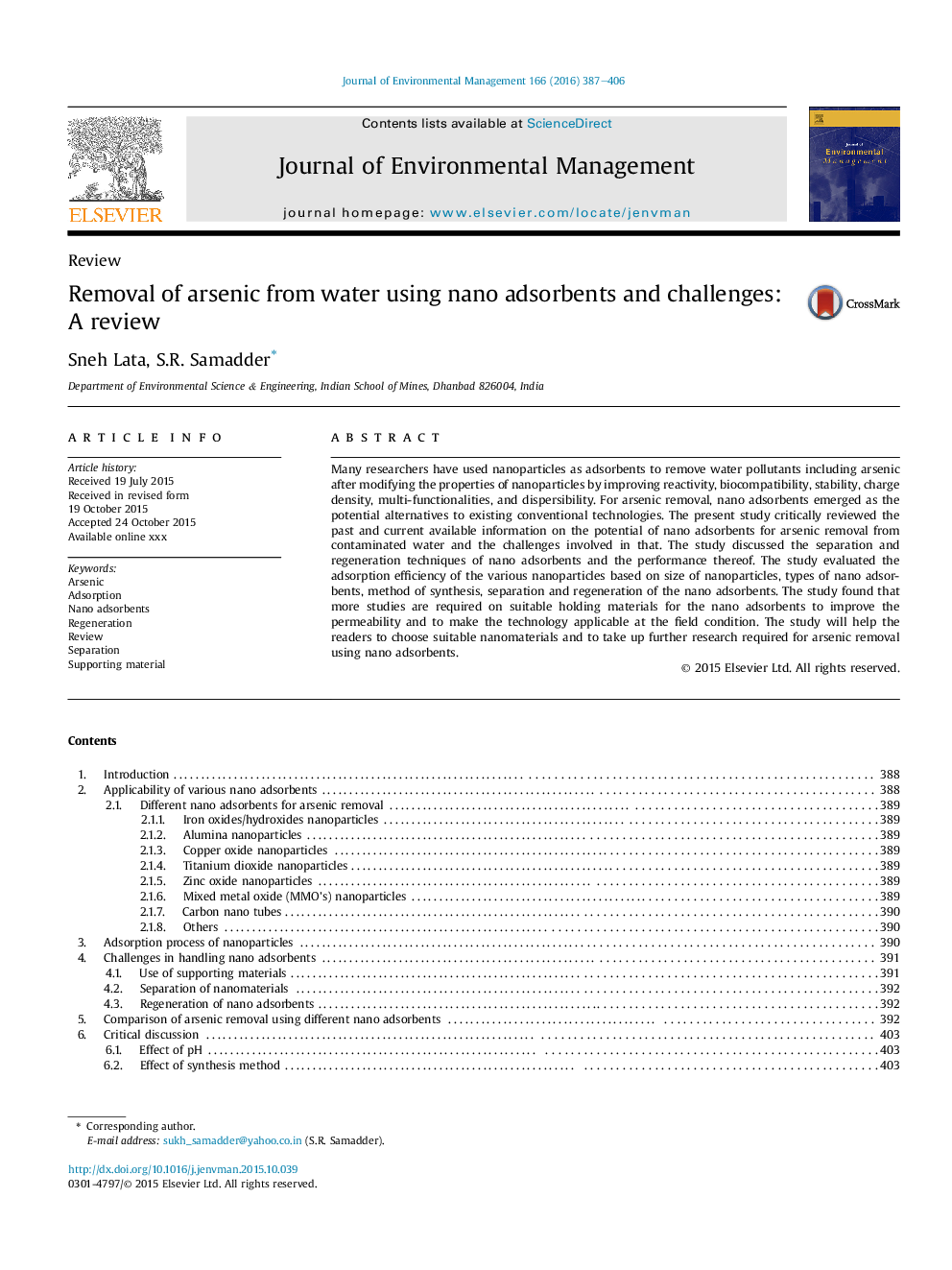| کد مقاله | کد نشریه | سال انتشار | مقاله انگلیسی | نسخه تمام متن |
|---|---|---|---|---|
| 7481394 | 1485246 | 2016 | 20 صفحه PDF | دانلود رایگان |
عنوان انگلیسی مقاله ISI
Removal of arsenic from water using nano adsorbents and challenges: A review
ترجمه فارسی عنوان
حذف آرسنیک از آب با استفاده از جذب نانو و چالش: بررسی
دانلود مقاله + سفارش ترجمه
دانلود مقاله ISI انگلیسی
رایگان برای ایرانیان
کلمات کلیدی
آرسنیک، جذب، جاذب نانو، بازسازی، مرور، جداسازی، حمایت از مواد،
ترجمه چکیده
بسیاری از محققان از نانوذرات به عنوان جاذبهای برای حذف آلودگیهای آبی از جمله آرسنیک پس از اصلاح خواص نانوذرات با بهبود واکنش پذیری، سازگاری با محیط زیست، ثبات، چگالی شارژ، چند کارکرد و پراکندگی استفاده کرده اند. برای حذف آرسنیک، جذب نانو به عنوان جایگزین های بالقوه برای فن آوری های متعارف موجود ظهور کرد. در این مطالعه، اطلاعات موجود و موجود در مورد پتانسیل نانوذرات برای حذف آرسنیک از آب آلوده و چالش های مرتبط با آن بررسی شده است. در این مطالعه، تکنیک های جداسازی و بازسازی نانوذرات و عملکرد آنها مورد بحث قرار گرفت. این مطالعه، کارایی جذب نانوذرات مختلف بر اساس اندازه نانوذرات، انواع نانوذرات، روش سنتز، جداسازی و بازسازی نانوذرات را مورد بررسی قرار داد. این تحقیق نشان داد مطالعات بیشتری در مورد مواد نگهدارنده مناسب برای جذب نانو برای بهبود نفوذ پذیری و استفاده از تکنولوژی در شرایط مزرعه مورد نیاز است. این مطالعه به خوانندگان کمک خواهد کرد که نانومواد مناسب را انتخاب کنند و تحقیقات بیشتری را برای حذف آرسنیک با استفاده از نانوذرات جذب کنند.
موضوعات مرتبط
مهندسی و علوم پایه
مهندسی انرژی
انرژی های تجدید پذیر، توسعه پایدار و محیط زیست
چکیده انگلیسی
Many researchers have used nanoparticles as adsorbents to remove water pollutants including arsenic after modifying the properties of nanoparticles by improving reactivity, biocompatibility, stability, charge density, multi-functionalities, and dispersibility. For arsenic removal, nano adsorbents emerged as the potential alternatives to existing conventional technologies. The present study critically reviewed the past and current available information on the potential of nano adsorbents for arsenic removal from contaminated water and the challenges involved in that. The study discussed the separation and regeneration techniques of nano adsorbents and the performance thereof. The study evaluated the adsorption efficiency of the various nanoparticles based on size of nanoparticles, types of nano adsorbents, method of synthesis, separation and regeneration of the nano adsorbents. The study found that more studies are required on suitable holding materials for the nano adsorbents to improve the permeability and to make the technology applicable at the field condition. The study will help the readers to choose suitable nanomaterials and to take up further research required for arsenic removal using nano adsorbents.
ناشر
Database: Elsevier - ScienceDirect (ساینس دایرکت)
Journal: Journal of Environmental Management - Volume 166, 15 January 2016, Pages 387-406
Journal: Journal of Environmental Management - Volume 166, 15 January 2016, Pages 387-406
نویسندگان
Sneh Lata, S.R. Samadder,
